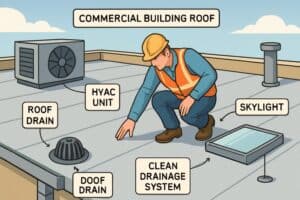Table of Contents
- Introduction
- Regular Inspections and Maintenance
- Ensure Proper Drainage
- Invest in Quality Materials
- Implement Protective Coatings
- Manage Roof Traffic
- Address Repairs Promptly
- Monitor for Vegetation Growth
- Stay Informed About Emerging Technologies
Key Takeaways
- Regular inspections and proactive maintenance are crucial for maintaining the longevity of commercial roofs.
- Quality materials, professional repairs, and innovative technologies play a critical role in roof durability.
- Proper drainage, vegetation control, and roof traffic management prevent costly damage and extend roof life.
Introduction
Protecting a commercial building is an investment in long-term success, and the roof is one of the most critical protective barriers. Beyond shielding your property from rain, wind, and intense sunlight, a sturdy, well-maintained roof ensures occupant safety and contributes to energy efficiency. Working with industry-leading professionals such as Deltaservices.com gives you access to cutting-edge expertise and solutions specifically tailored to maximize your roof’s longevity and performance.
Routine roof care, high-quality materials, and timely repairs significantly reduce major expenses and disruptions. With the right commercial roofing strategies in place, property owners and managers can avoid premature roof replacement and unexpected leaks or damage. Follow the comprehensive steps below to ensure your commercial roof withstands the test of time—and unpredictable weather.
Regular Inspections and Maintenance
Scheduling regular roof inspections is the foundation of proactive maintenance and longevity. Experts recommend having your commercial roof professionally inspected at least twice a year, preferably in the spring and fall, and immediately following any severe weather event. According to Insurance Journal, these inspections are critical for spotting issues early, such as surface cracks, membrane blisters, punctures, and areas of standing water. Early detection enables prompt intervention, preventing minor problems from developing into costly structural issues. Keeping detailed records of inspection results and repairs also helps in planning future maintenance and budgeting accordingly.
Ensure Proper Drainage
Water accumulation is one of the leading causes of premature roof deterioration. Effective drainage systems—gutters, downspouts, and internal drains—must be kept clean and free from debris to prevent water from pooling and causing leaks, mold, or even structural collapse. Regularly inspect and clear out all drainage components. If your roof experiences chronic ponding, consider upgrading or adding new drainage features or adjusting the roof pitch to optimize water flow.

Invest in Quality Materials
Roofing materials are not created equal—selecting the right materials for your geographic location and building requirements can significantly impact your roof’s longevity and performance. Popular commercial options include TPO (Thermoplastic Olefin) and EPDM (Ethylene Propylene Diene Monomer), both celebrated for their resilience, flexibility, and energy-saving properties. According to The Spruce, understanding the pros, cons, and costs of each roofing material can help property owners make more informed decisions.
Although premium materials may require a higher upfront investment, they often save time and money in the long run by lowering the frequency of repairs and commercial roof replacements. Consult with experienced roofing specialists to choose systems that meet your building’s specific needs and resist local weather patterns.
Implement Protective Coatings
One of the most effective strategies for extending a commercial roof’s lifespan is the use of protective coatings. These are applied to existing membrane systems and offer a host of benefits, including increased UV resistance, lower heat absorption, improved waterproofing, and, in some cases, reflective properties that reduce cooling costs during the summer months.
Maintaining the effectiveness of these coatings requires periodic reapplication, as per the manufacturer’s guidelines, especially in areas exposed to extreme weather or heavy sunlight. Reflective coatings, in particular, transform commercial roofs into energy-saving assets, supporting both environmental and economic goals.
Manage Roof Traffic
Unrestricted foot traffic is a common but preventable source of commercial roof damage. The solution: restrict roof access to only essential personnel and implement designated walkways or pads to distribute weight and minimize wear and tear. Employees and contractors should be educated on the importance of using these pathways and respecting restricted zones.
Taking these steps not only extends the roof’s lifespan but also reduces the risk of accidents and liability, which are critical concerns for property managers and owners.
Address Repairs Promptly
Ignoring minor roof problems can quickly escalate repair costs and trigger widespread structural damage. Issues such as diminutive leaks, detached flashing, or surface deformation should always be addressed immediately through professional service.
Establish a preventive roof maintenance program with rapid response protocols for repairs to keep your building safe and maintainable, while keeping your maintenance expenses manageable.
Monitor for Vegetation Growth
Vegetation such as moss, algae, and lichen may seem harmless, but can compromise roofing materials and water drainage, especially in humid climates. Regularly scan your roof for signs of organic growth. Remove any vegetation and consider preventive treatments, such as low-toxicity biocides, to minimize regrowth and structural impact.
Stay Informed About Emerging Technologies
The commercial roofing industry is constantly evolving, introducing technologies that enable smarter, faster, and more efficient maintenance. Smart roofing systems equipped with wireless sensors now monitor structural health in real time, instantly alerting building owners to potential issues such as leaks or insulation failure.
Additionally, sustainable innovations—such as green roofs and integrated solar panels through solar panel installation services—not only extend the lifespan of the roof but also boost energy efficiency, qualify for tax incentives, and improve overall property value.

